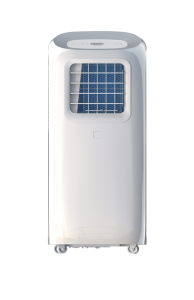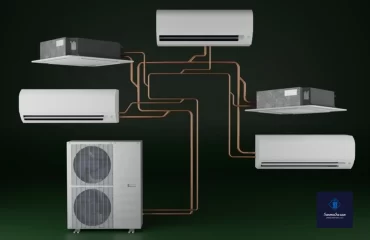What device is an air conditioner?
The air conditioner is one of the components of an air conditioning system which, like any other air conditioner, is responsible for regulating temperature, air circulation, humidity regulation and air purification. The air conditioner is not a source of cold and heat, but as its name implies, it is solely responsible for the distribution and circulation of air, which can be hot or cold. In this way, air conditioners can be used both in hot seasons and in cold seasons.
In this way, hot or cold air, after passing through different parts and passing through the desired filters, enters the air conditioner and is blown to the desired part through the air conditioner outlet. This hot or cold air must be supplied from a cooling or heating source, so the air conditioner is combined with heating systems such as boilers, packages, hot water boilers and other items or cooling systems such as chillers, splits, air conditioners and others. It is not used alone. Air conditioners can operate both indoors and outdoors, such as on balconies.
What are the types of air conditioners and what is a home air conditioner?
There are different air conditioners for different uses and purposes. One of these air conditioners, in addition to industrial and hygienic types, is an apartment air conditioner, which of course has no limited application to residential apartments. Apartment air conditioners can be installed in commercial, recreational, residential, office and other buildings. Of course, depending on the type of use of the building structure, air conditioner details such as filters, installation of humidity controller or not, and dimensions can be changed. The reason for the name of this air conditioner is that it is produced in limited capacity and sizes and is naturally not suitable for large industrial and production projects.
Usually, when the name of household or apartment goods is mentioned, which is less hassle, the product is supposed to be compact and small, meet the needs of a building, and finally a lot of cost in terms of installation, purchase and repair. Do not follow. For this reason, when we talk about an apartment air conditioner, we mean a small and lightweight air conditioner that has a simple building and is located in the form of a rectangular cube space.
How apartment air conditioners work
Before working on apartment air conditioners, the tasks defined for them should be mentioned again. These include regulating the temperature or, in fact, the entry of hot or cold air, regulating the humidity, creating air circulation, and purifying the air. In general, the air conditioner works in such a way that it sucks part of the air in the environment in which it is installed, after this suction, it combines the air with a part of the air outside the environment, performing various actions such as purifying or reducing or increasing It absorbs moisture on it and returns it to its previous environment through channels.

Components of apartment air conditioner
- Fan: The fan, which is one of the main components of the air conditioner, is responsible for blowing and sucking inlet and outlet air. In apartment air conditioners, centrifugal fans or centrifuges are used, which work in both directions, both forward and backward. The amount of noise pollution in the fans of this type of air conditioner is very important.
- Filters: Filters through which incoming and outgoing air also naturally play a role in air purification. Three types of oil filters, dry and bag filters can be available inside the air conditioner, and if all three are installed, the air will be completely purified. Each of these filters does a specific job.
The oil filter consists of a layer of cloth or polymer fibres on which a layer of odourless oil is placed and the airborne particles adhere to this oily surface which acts as an adhesive and the rest of the air will pass through the fibres. The dry filter can be the same type of oil filter but without any oil. This layer is more like a pre-filter. Finally, the bag filter is made of several separate sections that inflate when air flows into it and trap airborne particles in its bag compartments.
- Coils: Coils are connected to heating and cooling systems in the hot and cold seasons so that they can heat and cool the environment in which they are installed. Of course, depending on the weather and climatic conditions of each place, the method of designing cooling systems for the air conditioner is different from each other. The way this section works is that the air sucked by the air conditioner passes through the coils that are connected to the hot or cold water source, the temperature increases or decreases, and after passing through different filters and the outlet valve to They enter the environment. Electric heaters can also be used in the building to heat the air conditioners, which work in the same way as before. Doing so reduces the energy consumption of the entire building.
- Humidifier or dehumidifier: This factor is mostly installed in industrial air conditioners, but it can also be installed for apartment air conditioners depending on the needs of consumers. There are nozzles for the part that densely spray water particles into the air.
- Control factors: In the air conditioner, various factors are performed to work and operate on the air. The instruments controlling these functions are temperature sensors, humidity sensors, thermostats and other electronic controls.
Factors determining the quality and superiority of apartment air conditioners
Apartment air conditioners have a simple building and limited determining factors in this regard affect the quality of construction. But on the other hand, its place of use creates special sensitivities. These sensitivities are more open to the comfort and convenience of consumers
- Minimize noise pollution by the accurately static balancing of fans and components. This is one of the most important aspects of apartment use, as it affects the comfort of the occupants or clients. In this model of air conditioners, centrifugal fans are used.
- Body material for outdoor or indoor use. Galvanizing the air conditioner coating is one of them in order not to be damaged by environmental factors and not to be oxidized.
- Equipped or not equipped with an energy recovery system.
- High efficiency of the air conditioner.
- The volumetric capacity of the air conditioner, which in turn determines the contact surface of the coils with hot or cold air.
- Air conditioner fan pressure for a uniform air transfer to all parts of the building.

 English
English  فارسی
فارسی 



